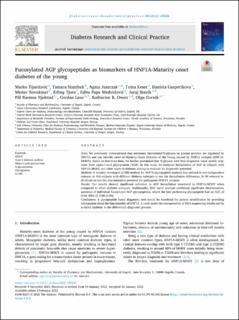| dc.contributor.author | Tijardović, Marko | |
| dc.contributor.author | Štambuk, Tamara | |
| dc.contributor.author | Juszczak, Agata | |
| dc.contributor.author | Keser, Toma | |
| dc.contributor.author | Gasperikova, Daniela | |
| dc.contributor.author | Novokmet, Mislav | |
| dc.contributor.author | Tjora, Erling | |
| dc.contributor.author | Pape Medvidović, Edita | |
| dc.contributor.author | Stanik, Juraj | |
| dc.contributor.author | Njølstad, Pål Rasmus | |
| dc.contributor.author | Lauc, Gordan | |
| dc.contributor.author | Owen, Katharine R. | |
| dc.contributor.author | Gornik, Olga | |
| dc.date.accessioned | 2022-10-10T06:58:23Z | |
| dc.date.available | 2022-10-10T06:58:23Z | |
| dc.date.created | 2022-05-18T15:24:05Z | |
| dc.date.issued | 2022 | |
| dc.identifier.issn | 0168-8227 | |
| dc.identifier.uri | https://hdl.handle.net/11250/3024883 | |
| dc.description.abstract | Aims: We previously demonstrated that antennary fucosylated N-glycans on plasma proteins are regulated by HNF1A and can identify cases of Maturity-Onset Diabetes of the Young caused by HNF1A variants (HNF1A-MODY). Based on literature data, we further postulated that N-glycans with best diagnostic value mostly originate from alpha-1-acid glycoprotein (AGP). In this study we analyzed fucosylation of AGP in subjects with HNF1A-MODY and other types of diabetes aiming to evaluate its diagnostic potential.
Methods: A recently developed LC-MS method for AGP N-glycopeptide analysis was utilized in two independent cohorts: a) 466 subjects with different diabetes subtypes to test the fucosylation differences, b) 98 selected individuals to test the discriminative potential for pathogenic HNF1A variants.
Results: Our results showed significant reduction in AGP fucosylation associated to HNF1A-MODY when compared to other diabetes subtypes. Additionally, ROC curve analysis confirmed significant discriminatory potential of individual fucosylated AGP glycopeptides, where the best performing glycopeptide had an AUC of 0.94 (95% CI 0.90–0.99).
Conclusions: A glycopeptide based diagnostic tool would be beneficial for patient stratification by providing information about the functionality of HNF1A. It could assist the interpretation of DNA sequencing results and be a useful addition to the differential diagnostic process. | en_US |
| dc.language.iso | eng | en_US |
| dc.publisher | Elsevier | en_US |
| dc.rights | Attribution-NonCommercial-NoDerivatives 4.0 Internasjonal | * |
| dc.rights.uri | http://creativecommons.org/licenses/by-nc-nd/4.0/deed.no | * |
| dc.title | Fucosylated AGP glycopeptides as biomarkers of HNF1A-Maturity onset diabetes of the young | en_US |
| dc.type | Journal article | en_US |
| dc.type | Peer reviewed | en_US |
| dc.description.version | publishedVersion | en_US |
| dc.rights.holder | Copyright 2022 the authors | en_US |
| dc.source.articlenumber | 109226 | en_US |
| cristin.ispublished | true | |
| cristin.fulltext | original | |
| cristin.qualitycode | 1 | |
| dc.identifier.doi | 10.1016/j.diabres.2022.109226 | |
| dc.identifier.cristin | 2025348 | |
| dc.source.journal | Diabetes Research and Clinical Practice | en_US |
| dc.identifier.citation | Diabetes Research and Clinical Practice. 2022, 185, 109226. | en_US |
| dc.source.volume | 185 | en_US |

